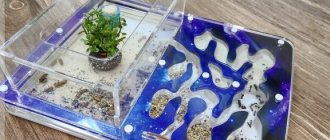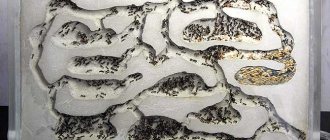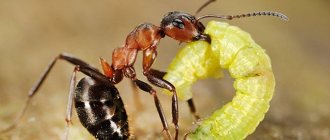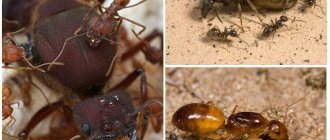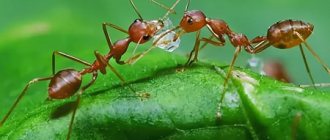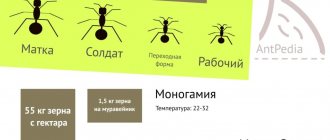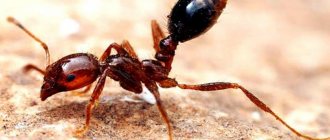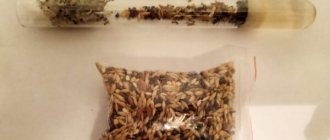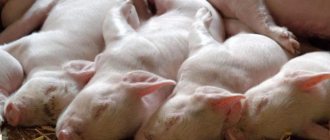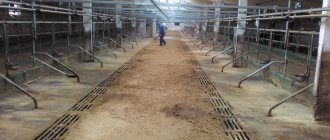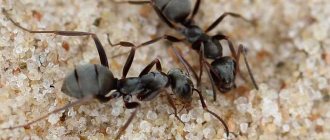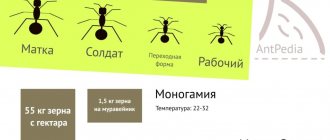An ant farm is a cross-section of an artificial anthill. Such farms are also commonly called formicariums. They allow you to observe the life of ants through the front wall. The popularity of this activity is due to the fact that observing the life of insects on a farm allows you to relax, relieve stress and forget about all everyday problems.
When choosing a formicarium for your home, the future farm owner should pay attention to the following criteria:
- modification;
- safety;
- type of filler;
What is an ant farm?
An ant farm is a home anthill, which is a container filled with a special gel, sand or other filler.
In it you can easily observe everything that happens inside the ant family. Scientifically, an ant farm is called a “formicarium”. For the Russian market this product is still quite exotic. But gradually formicaria are gaining well-deserved popularity.
An ant colony is like an exotic pet. There are no special problems in its maintenance, and observing the inhabitants of the anthill is a very exciting activity. At the same time, you get the opportunity to see the development of the colony from the very beginning.
Recently, formicariums have begun to be purchased for offices. Some might want to use it on their desk, since farms are compact and don’t take up much space. And someone buys large farms for the hall or for the boss’s office.
Many people give ant farms as an original gift. Ants are social insects, so you can watch them for hours, they are constantly doing something and interacting with each other.
Children will simply love the ant farm! They are interested in what happens inside the anthill and how these insects develop. They have the opportunity to grow a huge family from a small colony of 20–25 ants. The formicarium also allows children to get to know nature better and, at least for a while, take their mind off gadgets. While looking after the ants, they learn a lot about the fascinating world of these insects, which have been living on our planet for several million years. And for adults, such observation is the best way to disconnect from everyday worries for at least an hour and let the body relax.
Inhabitants of the formicarium
There are a huge number of species of ants, completely different from each other. For example, there is such an amazing species as Amazon ants, which rob the anthills of other species and drag away the larvae from there. Subsequently, the captive ants become their slaves and look after the Amazons.
There are leaf-cutter ants that live inside the mycelium, which they grow themselves. Their jaws are very well adapted for cutting leaves into small pieces and carrying them to the mycelium, and then building a dwelling from it, as well as feeding on it.
There are real giants in the world of ants, reaching a length of 4 centimeters.
Ants are mainly divided into hunters and gatherers. Hunters need protein food and carbohydrates; they are predators and hunt insects. It is very interesting to watch how ants use their antennae to chase prey by smell. When one of the ants finds syrup or fruit, on the way back to the anthill, it marks the road with its abdomen, which allows its fellows to quickly find their way to food. All these interesting points will be clearly visible to you in your home farm.
Gatherer ants differ from hunters in the peculiarities of their content. They feed mainly on what they find. Mostly these are plant seeds (poppy, rapeseed, millet). They will also not refuse protein foods. They can eat dead insects or the same boiled chicken (if we talk about a home ant farm). They do not hunt insects, they only defend themselves. But these ants have a very interesting internal structure of the anthill. There are food storage chambers (warehouses where they store seeds for a long time), birth rooms, dining rooms (where they bring seeds, soften them with moisture and eat them), rooms for caring for the young (in these rooms the ants care for and feed the larvae). And all the processes that occur in the formicarium can be observed with your own eyes!
As a rule, insects within the same family are divided into castes: scouts, workers, nurse ants, soldiers and queen. Almost every species has scouts; they make up a small percentage of the total population of the anthill. Their task is to explore unfamiliar territories and look for new sources of food. Workers are the main hard workers of the colony; they build, transport food, sort warehouses, and clean the anthill. Soldiers differ from the rest in their larger size, have a large head and powerful jaws. The nannies practically do not leave the young; they feed the larvae and the queen itself.
The queen is person No. 1 in the colony. All the inhabitants of the anthill are born from the same womb, that is, they are all brothers. The task of the uterus is only to give birth to new ants. She doesn't even get food herself. There are some species in whose colonies several queens can exist.
Each anthill and its inhabitants have their own unique smell, so even ants of the same species, but from different anthills, will be at enmity with each other.
Where to get ants
To move into the gel formicarium, you can catch ordinary ants. The disadvantage of this approach is that it is not always possible to find the queen ant. Without it, ants may be lethargic and will not live very long. Such a colony cannot be called a full-fledged one.
You can find the queen ant during flight - when for the only time in her life she climbs to the surface with male ants for mating, which takes place in the air. It is at this time that there is a chance to catch the queen ant - although this is quite difficult.
It is possible to order ants online. Sometimes they are sold together with formicarium and related products - food, etc.
Main types
A horizontal ant farm is inconvenient because it takes up more space than a vertical one.
These designs come in several types:
- Horizontal. These are “lying” farms in which the main slab is located horizontally, as in natural anthills.
- Vertical. The main slab “does not lie”, but is in a standing position, imitating tiered ant dwellings.
- Complex. It combines several types at once: both nests and an arena are located inside, they are larger in size, reminiscent of an ant town.
- Island. The arena is surrounded by a water moat, there is a farm in the middle, no nets or glass are required. The main thing is to monitor the water level and clean the moat.
Ant farms can also be divided according to the material from which they are made. Plaster, acrylic, gel and even wood are used.
The most common designs are made of plaster and acrylic: they are easy to make and do not require frequent repairs. Wooden ones have faded into the background due to the fact that they quickly become unusable: the wood begins to rot, becomes less durable, and falls apart.
How and where to choose the right ants
The first step is to select insects to keep. This can be done in two ways:
- Make a purchase in pet stores (usually online stores). There you will additionally be offered a complete list of materials necessary to create a comfortable ant home. This option, of course, is very convenient, but there are also disadvantages - high cost and the risk of ants dying during transportation, especially if the store is located in another city. In addition, in most cases in such places ants are sold without a queen, which is responsible for reproduction. This means that your farm will last about two months until all its inhabitants die.
- Find an anthill in a park, garden or forest and recruit pets yourself. You can even get the soil they are used to. But ants caught in this way will also not be able to reproduce. Therefore, it is best to find an anthill during the mating flight and catch the queen. Such an anthill is easy to notice: these insects have wings and accumulate en masse on the surface in order to fly away to create new colonies. By placing the queen in a formicarium, after some time you will receive a full-fledged colony. The main thing is to wait until the larvae mature, the farm will gradually fill with ants and begin to live its own life.
Important! You should not destroy the anthill in search of the queen; by doing this you will not only harm nature, but also doom this colony to extinction: only the queen bears offspring. In addition, after the creation of a new colony, the queen’s wings disappear, and given the huge horde of insects, it will be quite difficult to distinguish her.
Benefits of Feeding Reaper Ants
Unlike the others, reapers are more convenient and unpretentious in breeding. For proper nutrition, you don’t have to add food to them every two days. In addition, you do not need to breed any livestock, which brings a lot of trouble to many.
Therefore, if you breed Messor Structor ants, then you don’t need to grow anything or anyone else except the insects themselves. At the same time, they are developing well. Just keep in mind that food for harvester ants should consist of several varieties of grains.
Homemade formicariums
- Bulk formicarium. This is probably the simplest version of a homemade ant farm. The design is somewhat reminiscent of a window frame. Two glasses of the same size are glued together, leaving a gap of about two centimeters. A substrate of sand and clay is poured into the resulting container. The ants themselves make the transitions and equip separate chambers. This design is not ideal - there is a risk of collapse of tunnels and galleries, and high humidity can cause mold to develop. The ants try to build passages without touching the transparent glass, so part of their life is hidden from view.
- Wooden formicarium. An excellent option for lovers of natural materials and natural aesthetics. To make it, you will have to stock up on a serious set of wood carving tools and carpentry skills. A wooden ant farm beautifully complements the interior, but not all types of ants are suitable for living. In addition, in humid conditions, a wooden formicarium is susceptible to deformation and rotting.
- Gypsum formicarium. Gypsum is an excellent material for making an ant farm. Convenient to manufacture, practical to use. Mix gypsum powder with water and shape into desired size and shape. The frozen mass has good density, while absorbing a certain amount of moisture, and then gradually releasing it to the surrounding space. A humidity gradient is created in a home formicarium. This allows the ants to use the chambers depending on the conditions. Some are for storing supplies, others for raising larvae. Gypsum ant farms do not deform like wooden ones, and the passages in them do not collapse like in sand ones.
Omnivorous ants
These are hunter ants. In the ANTKingdom online store you can purchase three types of such ants: reapers, black gardeners and giants. They are not picky eaters and take root in almost any formicarium. The diet of black garden ants (lasius niger) includes almost everything from boiled meat to dried gammarus. The same can be said about the reapers (messor constructor). The only difference is that black gardeners eat sweets (syrup), but it is contraindicated for reapers. Therefore, reapers are forbidden to give sweets, as they may die due to dehydration.
What will you need for your farm?
You need two jars with lids - one larger, one smaller (so that the second can fit inside the first). Ants and soil will be placed in the space between the small and large containers. A smaller jar is needed to leave space in the center.
The ants will be able to lay eggs at the top edge and build tunnels, and you will be able to watch this process. Airtight containers are great for “construction”. You can use them to create the desired size of farm. Please note that the jars should not have any patterns, cracks, scratches, etc. If you want your ant farm (with ants) to be flat, buy a small narrow aquarium from your local pet store.
How to build a formicarium
Now let's proceed directly to the construction of the farm. I must say that this is a very interesting and exciting process where you can use your creativity. Below are the most commonly used models of ant houses.
Important! Before starting work, you need to take a closer look at the life of ants. Information can be gleaned from books, found on the Internet, or simply asked by experts on keeping these insects at home. This knowledge is important for achieving success in this business!
Soil-sandy
To make this housing option, you need to select two plastic jars with tight lids (you can also use glass containers). Their size should be such that one fits freely into the other and there is still some free space left.
Next, do the following:
- In a smaller jar, close the lid tightly and place in a larger container;
- pour a soil-sand mixture in a 2:1 ratio between the jars;
- take a small stick, make a depression in the filler, place the ants there and the work will begin to boil;
- close the outer jar with a lid, but first make small holes in it for ventilation;
- very soon the insects will dig tunnels for themselves, and you will be able to observe their life;
- food for ants is placed on the lid of the inner jar.
Important! Do not use paper or fabric as covers; ants can easily gnaw through such materials and spread throughout the house.
With gel filler
This type of formicarium is very convenient, since the gel is a universal material in which tunnels can be dug, offspring can be raised, and even consumed as food. Pet stores sell a ready-made gel composition made from seaweed. It is made colored (usually blue) and transparent. But you can make the gel with your own hands.
DIY gel
To do this, take:
- food gelatin (15 gram package) – 3 pcs.;
- hot water – 1 l;
- flat transparent plastic container with a lid.
Pour half the hot water over all the gelatin and dissolve completely by stirring, then add the rest of the water. Pour the resulting composition into the prepared container and place in the refrigerator. Wait until the gel hardens, then take it out and warm it to room temperature. Now you can make a hole and move residents there.
Ants in a farm with gel
Insects feel great in the gel farm: they dig tunnels, feed, and so on. This is perhaps the best formicarium option for busy people. Its main feature is that ants do not need anything to drink or eat; their source is the gel.
And when the gel runs out, just add a new portion. Such manipulations can be carried out as many times as desired.
Did you know? Ants engage in animal husbandry by raising aphids, which provide them with sweet nectar. Just imagine a herd of aphids grazing peacefully under the supervision of ant guards!
Origin of Formicaria
The very first formicaria have been used since the 19th century for scientific purposes. They began to gain popularity in the second half of the twentieth century. The first example of an ant farm was patented by Frank Austin in 1931. It was a wooden frame with two glass panels located so close that the passages dug by the ants in the soil poured between them were visible from the side. Initially, its development served as a manual in educational institutions and museums. But the mass production of ant farms in the USA began in the 50s. Milton Levine.
His company began cooperation with NASA when the task arose of observing how insects would take root in conditions of weightlessness. It was NASA that developed a non-stick gel for filling the formicarium container. The translucent substance allows you to observe the behavior and movements of ants. It serves as both habitat and food. Insects gnaw passages in it, creating a home for themselves.
Acrylic
For an acrylic farm, the most difficult thing is to form passages and holes for ants
Required tools and materials
- pencil:
- paper;
- acrylic;
- polycarbonate;
- plastic rivets;
- cocktail tubes.
Step-by-step manufacturing instructions
- Develop a project for a future farm. To do this, on a sheet of paper you need to draw with a pencil the future structure, the approximate location of the tunnels, and the dimensions of the structure.
- Take acrylic and follow the example on paper to make small holes, the so-called passages.
- When the structure is ready, fasten it to the walls and polycarbonate lid using plastic rivets.
- Before settling the farm, it is necessary to insert cocktail tubes into the structure so that air, water and food flow through them.
From plaster
To make a gypsum ant farm with your own hands, you will have to spend more time, because... you need to wait for the material to harden
Required tools and materials
To create a gypsum farm, you will need:
- capacity;
- gypsum mortar;
- water;
- cocktail straw;
- pencil;
- drill;
- stationery knife.
Step-by-step manufacturing instructions
- The first step is to prepare a container for diluting gypsum.
- Mix water and plaster until the consistency of thick sour cream.
- Next, you need to leave it to harden for 5-7 days.
- Carefully remove the dried mass from the container.
- Use a pencil to draw future moves and exits.
- You can use a utility knife to drill small paths.
- Place the finished structure in an aquarium or jar of a suitable size.
- Make holes in the lid to allow air to enter.
- In order to moisten the ants' habitat and feed them, insert cocktail straws.
Care
Caring for ants does not cause much trouble, because the ant colony is a self-regulating system.
Did you know? These amazing insects are among the oldest species on Earth. The most interesting thing is that ants now look exactly the same as they did a hundred million years ago!
The main thing in this matter is to follow fairly simple rules:
- use sweet compounds or specialized feeds as food (except for keeping in a gel farm);
- do not forget about moistening the soil mixture, for which every week put a wet cotton swab on the lid and change it when it dries completely (for a gel farm this is not necessary);
- the temperature in the room where the formicarium is located should not fall below +15 degrees Celsius;
- do not allow sunlight to enter the ant house, because they love the dark;
- Be sure to remove dead individuals using a cotton pad, this will help avoid disease.
Let's sum it up
If you don’t know where to get ants for your farm and what type to choose, in most cases the ideal option will be reapers and here’s why:
- Pronounced polymorphism (different sizes). Thanks to this, it is much more interesting to observe such ants, because based on their size, they each perform their own tasks.
- Safety for humans and animals. Even the largest soldiers are not able to bite through the skin.
- Calm character.
- Do not cause allergic reactions.
- They do not require live food.
- Easy to breed. The only necessary condition is a humidity gradient (part of the formicarium must be wet and the other dry, so there must be gypsum inserts in the farm).
In addition to all of the above, harvester ants live in the south of Russia, that is, they do not need to be transported from other countries.
If this article has convinced you, and you are ready to buy harvester ants, you can do it right now. We work not only in Moscow, but are also ready to deliver insects, as well as farms of various species, to any place in the country.
Warnings
You should also know what not to do when using formicarium:
- close the lid tightly, insects need air to breathe;
- the holes in the lid for ventilation should be of such a size that pets cannot escape from you;
- do not allow strong cooling, otherwise you will be in sleep mode;
- ants are contraindicated in extreme heat, which will lead to the death of insects;
- do not shake or drop the formicaria;
- do not pour water, the ants cannot swim and will simply die.
In conclusion, let’s say that by creating a formicarium with your own hands, you will make a unique specimen, thanks to which you will be able to observe the life of your unusual pets.
Best Vertical Ant Farms
In a vertical formicarium, living spaces are most often located on floors. They are separated by partitions, which are removed as the family grows. Such designs are roomy and compact - they do not take up much space on the shelf.
7ants “Explorer XXL”
The large Izuchaika ant farm can accommodate up to 2000 individuals. It is designed specifically for children who are fascinated by the life of insects. Bright design in different colors will fit into any children's room. The set includes external decor for the body and colored stones for decorating the arena.
7 floors are separated from each other by plugs. Two test tubes with a sponge provide a gradient distribution of moisture throughout the nest. The spacious arena is equipped with openings through which you can attach another farm and increase the size of the colony.
Pros:
- double humidification system;
- holds up to 2000 ants;
- there are different colors;
- decor included;
- You can expand the farm if desired.
Minuses:
- is expensive (from 6,000 rubles).
To get acquainted with ants, it is better to buy a smaller farm. This model is worth choosing if the child shows a strong interest in insects
Crystal L 3.0
A formicarium made of transparent acrylic in a high-tech style looks great not only in a home interior, but also in office spaces. Chambers in the shape of smooth rectangles allow insects to make maximum use of space. An autonomous humidity module is built into the design. There is no danger of excess water appearing in the anthill. At the same time, the level of moisture varies in different chambers, which allows the ants to distribute tasks between the compartments.
The model holds up to 1500 medium-sized ants, suitable for beginner myrmickeepers and professionals. At the initial stage, only 35 individuals can be populated here, and then gradually open new volumes of the nest, changing the plugs between chambers. The large arena allows for a variety of decor. The lid can be easily removed for ventilation and cleaning the anthill.
Pros:
- laconic style;
- removable cover;
- autonomous humidity module;
- large arena for decoration;
- transformable for different numbers of residents.
Minuses:
- takes a long time to collect.
Assembly takes at least 1-2 hours. Each plate is packed in a protective film, which must be torn off and then washed with water. There are clear video instructions on the Internet, and to speed up the process, you can take a needle.
AntHouse Wild
This 5-story clear acrylic ant farm can grow indefinitely. Modules are connected to each other without restrictions on the number. The rigid coupling system ensures the attachment of formicaria without gaps. You can also connect an incubator tube to the design. The model holds about 1300-1400 harvester ants.
The supplied pipette is convenient for adding water to the anthill. The automatic humidification system allows you to leave it unattended for several weeks. The gypsum block maintains the desired humidity gradient. The floors are separated by steps and covered, if necessary, with complete partitions.
Pros:
- can increase indefinitely;
- well-thought-out humidification system;
- incubator connection available;
- spacious.
Minuses:
- non-demountable design.
The farm is sold assembled. When purchasing, you need to check the structure for any cracks that may have appeared during transportation.
Stalinka 3.0
The prefabricated 5-story structure is made of 3 mm thick acrylic. The vertically located chambers of the nesting compartment are adjacent to the built-in arena. The levels overlap easily. This allows you to populate any number of ants of different sizes. Maximum capacity – 1500 pets. The model is suitable for almost all common types of these insects.
Even a beginner can handle a simple humidity system. Transparent walls allow you to observe your pets. Due to the small size of the structure (15x10x10 cm), it can be placed in any convenient place, but it is not advisable to move it.
The model is presented in two colors – with a green floral pattern and with a wood texture. You can buy a farm without ants or complete with insects.
Pros:
- transparent walls;
- 2 colors to choose from;
- level overlap system;
- built-in humidifier;
- compact size.
Minuses:
- You need to assemble it carefully, otherwise gaps may remain.
Stalinka 3.0 is a simple and reliable model that is popular among amateur myrmkeepers.
AntWorks "Dream"
An illuminated ant farm is an option for those who want to spend a minimum of time caring for new pets. The structure is made of plexiglass. A special biogel is poured inside, which serves as the basis for future passages of insects and their food. The only thing you need to do is to ventilate the formicarium from time to time. Additional feeding of insects is not recommended.
Transparent walls and a supplied magnifying glass allow you to observe the life of the anthill. A container measuring 18x14x3 cm can accommodate up to 20 large ants. Beautiful lighting from the USB cable makes the farm an interior decoration.
Pros:
- sold fully equipped;
- requires minimal care;
- convenient to observe the construction of passages;
- beautiful lighting.
Minuses:
- short life of pets;
- The gel is difficult to clean.
Ants live in gel formicariums for about 3 months if all maintenance rules are followed. However, if you place the farm in direct sunlight or near a heating device, the insects will die sooner. It will not be possible to use such a design to keep ants for a long time.
Proper farm hydration
Improper farm moisture is one of the leading causes of ant death. If you over-moisten the formicarium, this can promote the germination of grains and mold. Insufficient moisture will lead to drought and can completely kill the insects. There are general tips that indicate how to properly humidify ant farms.
For an average formicarium, use 1-3 ml of water twice a week or 5-8 ml of water once every 7 days.
However, these tips are quite conditional and you need to take into account the climate in which the ant farm is located and the place where it is located. In winter, the air in the apartment becomes dry and goosebumps need intensive hydration. The humidity inside the farm should be 30-80%. There are two main indicators that affect moisture leakage:
- Air humidity in the room in which the farm is located;
- The release of moisture leakage from the farm into the atmosphere. It depends on the design of the farm itself. It is of great importance whether the formicarium has a lid or other ventilation system through which moisture can escape.
Hydration can be spongy. If the sponge has a bright color, it is sufficiently moisturized. If the color is dull, it should be moistened. In gypsum drinkers, humidity is determined by the color of the gypsum. Wet gypsum is gray in color, dry gypsum is white.
After purchasing an ant farm, you should make your own moisture schedule by observing the state of the ants' behavior. Adjustments should not be made abruptly. It should be smooth and invisible to insects. If the humidity inside the formicarium is insufficient, but there is a drinking bowl in the arena, a large concentration of insects near the source of moisture will indicate to you that the humidity inside their home is insufficient. Drought can also lead to very rapid death of all insects. To be on the safe side, place a drinking bowl filled with water and a sponge inside the farm. Start moistening the farm with less moisture than stated in the instructions for your formicarium, since drought is much easier to cope with than waterlogging. Gradually increase hydration to the optimal percentage without notice.
Reaper ants are considered the best type of ants for beginners. They are calm and easy to obtain and grow.
Join our Facebook group
The best horizontal ant farms
A horizontal formicarium is a low system of chambers and passages. This popular type of farm is suitable for housing most types of ants. The viewing glass at the top of the structure allows you to take photos and videos of insects or simply watch them.
Antu Flow
Antu Flow is a horizontal ant farm with automatic humidification from a test tube. Thanks to it, the colony can be left without additional care for two to three weeks. Removable partitions allow you to care for different numbers of insects in the formicarium. The service life of gypsum is 1.5 years. It can then be changed without dismantling the farm or evicting the colony. Using darkening film, you can create a more comfortable environment for your pets.
The set includes soil in two colors and artificial plants to decorate the arena. The model is available in 5 different colors. If you need to increase the colony, the farms are connected to each other using a pair of complete tubes. Accidentally broken parts of the structure are easy to replace - the box with the anthill contains a set of additional parts.
Pros:
- automatic humidification system;
- modules are interconnected;
- 5 designs to choose from;
- rich equipment;
- opening partitions.
Minuses:
- high cost (from 4300 rubles);
- You can't buy it everywhere.
The farm can be purchased immediately with or without ants. Ready-made kits are very convenient for the first experience of caring for insects.
AntPlanet "Standard"
The prefabricated formicarium is designed for 1200 harvester ants. It is convenient to observe insects through the walls made of transparent acrylic. The spacious 4 cm high arena can be decorated to suit your taste. The structure is tightly closed with a lid - pets cannot get out. Also included is an anti-escape liquid. Humidity is maintained by two special chambers that need to be periodically filled with water.
The kit includes the parts from which the truss is built, as well as glue, plaster and a pipette for moisturizing. When purchasing a formicarium with ants, a year's supply of pet food is also included. Detailed instructions show how to assemble the farm. To increase the colony, you can connect several AntPlanet anthills with each other.
Pros:
- large arena;
- transparent body;
- full set;
- tight lid;
- can be connected to other farms;
- two humidification chambers.
Minuses:
- takes a long time to get ready;
- When humidity is high, condensation forms.
The model is suitable for medium and large ants, but is not recommended for small species.
Dangers when breeding ants
The first danger to the life of insects is your impatience. Do not rush to move the ants to a new home. This usually takes at least three days. You cannot shake off the uterus. If it falls, it can be damaged and die, and the death of the queen means the death of the entire colony.
The second danger is experimenting with food. Don't give ants anything you doubt. If you are not sure whether, for example, gingerbread or sausage can be eaten by insects, it is better to refuse such food.
The third mistake when breeding ants is the lack of information about their life. Before you buy an ant farm, learn as much as you can about breeding and caring for ants so as not to be disappointed and not destroy them.
Flood and drought pose a great danger to insects. There are situations when water from the drinking bowl gets into the living compartment, and cases when the cotton swab was chewed by ants or was not dense enough, as well as when the sponge is of the wrong size. If you notice an accumulation of water in a residential area, immediately provide the ants with the opportunity to leave this part of the farm and move to a dry area. They also require relocating insects to another formicarium when the seeds for feeding begin to germinate or when black mold appears on the walls.
